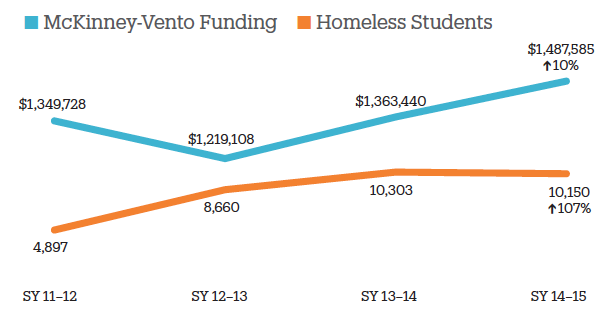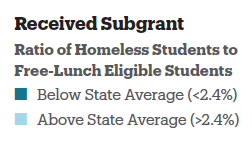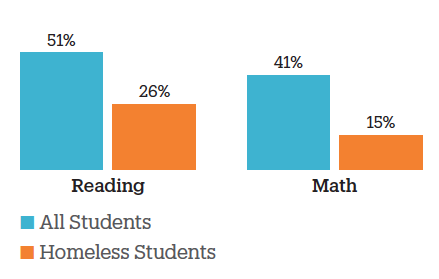Student Homelessness Snapshot
March 2018
- In the 2014–15 school year, New Jersey had 1,400,579 students enrolled in 681 local education agencies (school districts).
- That year, there were 10,150 homeless students in the state, making up 0.7% of total enrollment.
- New Jersey had the 33rd highest number of homeless students and the 49th highest rate of student homelessness in the U.S.
- School districts with the highest rates of student homelessness were Rancocas Valley Regional High (16%) and Delsea Regional High (14%), 22 times and 19 times the statewide rate, respectively.
FIGURE 1
Number of Homeless Students and Percent Living Doubled Up
By School District, SY 2014–15
The U.S. Department of Education’s definition of homelessness includes students who are “doubled up,” or have no option but to stay with others in overcrowded, often unsafe living conditions.



Source: U.S. Department of Education, Homeless Student Enrollment Data by Local Educational Agency School Year 2014–15.
- Three school districts had over 400 homeless students (Vineland Public, Edison Township, and Newark Public). In four school districts, over 9.5% of students were homeless, close to 14 times the statewide rate (Rancocas Valley Regional High, Delsea Regional High, Greater Egg Harbor Regional High, and Westville Boro Public).
- In 52 school districts (8% of all LEAs statewide), 100% of homeless students were sleeping in a doubled-up living arrangement. Vineland Public had almost 1,000 homeless students living in doubled-up conditions.
FIGURE 2
McKinney-Vento Funding and Number of Homeless Students
SY 2011–12 to SY 2014–15
The Education for Homeless Children and Youth program, established by McKinney-Vento, is the primary source of federal funding for homeless students in elementary and secondary school.

Source: U.S. Department of Education, State Funding History Tables by Program, Education Department Budget History State Tables, FY 1980–2014; National Center for Homeless Education, Federal Data Summary School Years 2011–12 to 2013–14 Education for Homeless Children and Youth, November 2015; National Center for Homeless Education, Federal Data Summary School Years 2012–13 to 2014–15 Education for Homeless Children and Youth, December 2016.
- Since SY 2011–12, New Jersey’s McKinney-Vento funding increased 10%, to $1,487,585. Over the same period the number of homeless students rose 107%, to 10,150. New Jersey had the highest rate of growth in student homelessness nationwide during that time, a rate almost 1.5 times the next highest state, Montana.
- On average, New Jersey received $146.56 per homeless student in SY 2014–15, down from $275.62 in SY 2011–12. Nationally, the per-student average for SY 2014–15 was $50.08.
FIGURE 3
School Districts Potentially Under-Identifying Homeless Students
By School District, SY 2014–15
School districts with lower ratios of homeless students to free-lunch eligible students are likely under-identifying those not in shelter.



Source: U.S. Department of Education, Homeless Student Enrollment Data by Local Educational Agency School Year 2014–15; National Center for Education Statistics, Local Education Agency (School District) Universe Survey Directory Data, SY 2014–15; National Center for Education Statistics, Public Elementary/Secondary School Universe Survey Free Lunch Data, SY 2014–15.
- In New Jersey, 26% of school districts had a ratio of homeless students to free-lunch eligible students below the statewide average.
- Three school districts had ratios at least ten times less than the statewide average (Union City, Cliffside Park, and Rahway Public).
- One-hundred percent of New Jersey’s 681 school districts received McKinney-Vento subgrants, and per-pupil funding was close to three times the national average. Hawaii, with only one school district, was the only other state to provide subgrants to all districts.
FIGURE 4
Proficiency in 4th Grade Reading and Math
SY 2014–15
Student performance in early grades is a strong predictor of high school graduation.

Source: U.S. Department of Education, ED Data Express, SY 2014–15; U.S. Department of Education, State Assessments in Reading/Language Arts and Mathematics School Year 2014–15.
- Statewide: On average, homeless students were proficient in reading and math at a rate 25–26 percentage points lower than all students.
- A closer look: Across all grades, Edison Township in Central New Jersey had the largest achievement gap in math and reading between all students and homeless students. The achievement gap for math was at least 35 percentage points and the gap for reading was at least 34 percentage points.
FIGURE 5
Homeless Students with Additional Support Needs
By School District, SY 2014–15
Students with disabilities or limited English proficiency may have difficulty accessing additional support services if they are homeless.



Source: U.S. Department of Education, Homeless Student Enrollment Data by Local Educational Agency School Year 2014–15.
- In three school districts over 60% of homeless students were identified as having a disability (West Orange Public, Mantua Township, and Little Egg Harbor Township), almost triple the statewide rate for all homeless students.
- In two school districts at least 40% of all homeless students had limited English proficiency (Fairview Public and Passaic City), five times the statewide rate for all homeless students.
FIGURE 6
Where Homeless Students Live, by Population Density
SY 2014–15
Families in rural areas or small towns often have fewer shelters or services to turn to for assistance.

Source: U.S. Department of Education, Homeless Student Enrollment Data by Local Educational Agency School Year 2014–15; National Center for Education Statistics, Education Demographic and Geographic Estimates (EDGE) Program, Geographic Indicators and Identifiers 2014–2015.
- In New Jersey, two-thirds of homeless students lived in suburban school districts. Four of those districts had at least 200 homeless students each (Edison Township, Elizabeth Public, Penns Grove-Carneys Point Regional, and Toms River Regional).
- Student homelessness was disproportionately seen in New Jersey’s urban areas. Despite enrolling only 11% of the total student population in the state, these districts accounted for almost a quarter of all homeless students.
Homeless students are too often overlooked by policymakers when talking about education policy. Improving outcomes
and supports for homeless students reduces the burden on teachers, parents, and schools who struggle to help students
cope with the trauma of homelessness along with the challenges of poverty.
Questions for educators and state/local legislators to consider:
- Has universal McKinney-Vento funding improved academic outcomes for homeless students? How is the money being used?
- Do you know how many homeless children live in your town? In your state?
- What supports are being provided to help homeless children toward better educational outcomes?
- Are the challenges that homeless students face, such as chronic absenteeism and difficulty traveling to and from school, being addressed?
- Are the educational needs specific to homeless students being identified?
- Does your public school have a dedicated liaison whose priority and focus is the needs of homeless students?
- Do schools coordinate with the shelter system or service delivery system?
- Are homeless students being granted access to services to which they are entitled (e.g. transportation, tutoring, special education, health care, food)?
This snapshot is part of a series analyzing student homelessness in all 50 states and the District of Columbia. Visit www.ICPHusa.org for more information.